
Fifty years after raising clenched fists in protest during the 1968 Mexico City Olympics, the shockwaves unleashed by John Carlos and Tommie Smith’s salute of defiance are still rippling around the sporting world.
The image of the African-American sprinters standing on the medal podium on October 16 1968, heads bowed while each raising a solitary, leather-gloved fist into the night sky would become one of the most iconic photos of the 20th century.
The protest redefined the concept of athlete activism as the stuffy, antiquated world of the Olympic movement under then president Avery Brundage collided with the political and cultural maelstrom raging across the globe in 1968.
America had already been convulsed by the twin assassinations of Dr. Martin Luther King in April and the murder of presidential hopeful Robert F. Kennedy in June. In between the trauma of those events, deadly rioting erupted in Chicago.
Large-scale protests against the Vietnam War gained momentum throughout a year which also saw civil unrest in France as student-led demonstrations and general strikes plunged the country into chaos.
By the time of the Olympics, the febrile mood sweeping the world had reached Mexico City.
Just days before the Games got under way, Mexican government forces crushed a protest by students and civilians.
Independent reports say between 300-500 people were killed, with thousands wounded and more than 2,000 arrested.
Bloody crackdown
That bloody crackdown set the stage for an Olympics that will forever be associated with Smith and Carlos’s “Black Power” salute.
On the morning of October 16, Smith won the 200m in a then-world record of 19.83sec, with Carlos taking bronze behind Australia’s Peter Norman.
At the medal ceremony that evening, Smith and Carlos proceeded with their planned protest which had been hatched before the Olympics.
The two sprinters had been drawn to activism while at San Jose State University in California, where they had been members of the Olympic Project for Human Rights (OPHR) set up by sociologist Harry Edwards.
As they walked out for the ceremony, the two athletes received their medal without shoes to symbolise black poverty in the United States.
Smith wore a black scarf to reflect black pride while Carlos wore a beaded necklace intended to represent “those individuals that were lynched or killed and no-one said a prayer for.”
Initially, both athletes had planned to bring gloves, but Carlos forgot his so the two men shared Smith’s pair.
All three sprinters on the podium — Carlos, Smith and Norman — wore badges of the OPHR.
“People started applauding vigorously and then all of a sudden I guess all the Yankees that was in the crowd decided they didn’t like what they were seeing, and they turned to venom and anger,” Carlos said at a symposium in Mexico City last month.
“And it kind of sent me into a state of shock.”
“I left the victory stand at the end of that day with the thought in mind that I was born June 5, 1945 to be in Mexico City October 16, 1968. That was my calling in life.”
‘Greatest sadness’
The repercussions for Smith and Carlos were severe.
Brundage, the International Olympic Committee’s American President, furiously demanded the duo be kicked out of the Games for what a spokesman decried as “a violent breach” of the Olympic spirit.
Within two days, the United States Olympic Committee had bowed to an IOC demand that Smith and Carlos be sent home, where they were greeted by opprobrium including death threats.
Carlos blames the 1977 suicide of his wife Kim on the turbulent aftermath of the controversy, calling it the “greatest sadness” of his life.
As Smith and Carlos grappled with the consequences of their protest, the rest of the sports world was also fundamentally altered.
Dave Zirin, the sports editor of The Nation magazine and author of “The John Carlos Story: The Sports Moment that Changed the World”, believes the 1968 protest handed greater power to athletes throughout sport.
“The raising of those fists and the larger revolt of the black athlete scared the holy hell out of the sports world,” Zirin told AFP.
“Everything you see in the 1970s with the loosening up of things like free agency and higher salaries, can be traced to that moment in 1968.
“And that has meant untold fortunes for generations of black athletes.
“The fear factor it engendered, and the way that athletes said ‘Wait a minute — these Games are about us, and we’re going to enforce our political will upon them.'”
Zirin said the activism of recent athletes such as former San Francisco 49ers quarterback Colin Kaepernick was linked directly to Carlos and Smith.
“So many athletes cite 1968 as their touchstone, to say ‘Hey, it’s happened before, this is our legacy as protesting athletes, and we’re not giving up that legacy,” he said.
“So when you see athletes standing on the sideline raising a fist, they’re doing it because of the connection to Tommie Smith and John Carlos.”




